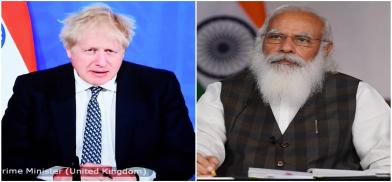India must shed its diffidence on a full-fledged FTA with UK
If India seeks greater market access, it must also allow the UK to sell more of its goods and services, writes N. Chandra Mohan for South Asia Monitor

Not so long ago, India signaled that it was not keen on free trade agreements, especially if these happened to deal with China by stealth. It walked out of the Regional Comprehensive Economic Partnership (RCEP), comprising the Association of Southeast Asian Nations together with China, Japan, South Korea, Australia and New Zealand. India is also reviewing its FTAs with ASEAN, Japan, South Korea and other countries.
Times now are a-changing with 20 deals currently under negotiation, and pacts with at least six including the UK, United Arab Emirates, Gulf Cooperation Council, Australia, Canada and the European Union being fast-tracked.
Deep down, however, India remains ambivalent regarding trade agreements. The apparent change of heart has more to do with the compulsions of boosting exports as an engine of growth.
The government has announced ambitious targets of USD 400 billion this year and USD 2 trillion in goods and services exports by 2030. As this cannot be achieved with an inward-looking protectionist regime, the government is exploring agreements with “democracies” that believe in ‘transparent rule-making trading opportunities”, stated Piyush Goyal, India's commerce and industries minister.
But a big stumbling block is the opposition of stakeholders like India Inc and farmers. They remain far from enthusiastic about RCEP and FTAs in general as the typical experience has been of trading partners inundating the domestic market with cheaper foreign goods while importing relatively less Indian goods, resulting in huge trade deficits.
Mini-FTAs
For such reasons, the level of ambition in the six-odd deals being fast-tracked is for early harvest agreements or mini-FTAs for trade in a limited set of goods and services. They could be a precursor for a full-fledged FTA, but only much later.
India’s reluctance to go the whole distance in inking full-fledged FTAs contrasts sharply with the enthusiasm shown by the UK. While India opted out of a Sinocentric RCEP in November 2019 and “the whole country heaved a sigh of relief”, according to Goyal, the UK, for its part, sees bustling possibilities in dealing with the booming economies of the Indo-Pacific.
After exiting the EU, the UK thus is eager to stitch up deals, especially with the 11-member Comprehensive and Progressive Agreement for Trans-Pacific Partnership that includes the fast-growing Vietnam, Malaysia and Mexico by end of 2022.
“Two-thirds of the world’s middle classes are going to live in Asia by 2030 and the types of products they are demanding are types of things Britain produces – whether those are high-value manufactured goods, quality food and drink, digital and data products, financial services,” stated UK’s Trade Secretary Elizabeth Truss to the Financial Times.
Of the one billion Asians joining the middle class, 250 million will be from India. Although both UK and India agreed on an Enhanced Trade Partnership for a roadmap towards a comprehensive FTA, India seeks an Interim Trade Agreement to deliver early gains.
Considering the long historic association and the growing stakes Indian companies have acquired in the UK, the preference for a mini FTA betrays a reluctant globalizer’s instincts. With bilateral trade volumes of USD 13 billion, India enjoys a trade surplus of USD 3.2 billion in 2020-21.
UK-India trade prospects
Two-way trade will double by 2030 if both partners continue to invest in each other. India is the second-largest source of inward investments into the UK with 99 investment projects that created 4,830 jobs in 2020-21, according to the UK’s Department of Industry. The UK is the sixth-largest investor in India.
Trade is bound to look up even more if both partners also agree to remove trade barriers on the path to full-fledged FTA. Negotiations entail a process of give and take for greater access to each other’s markets.
Despite the advantage of a trade surplus in India’s favor, an ambitious deal is not on the cards so long as the simple average tariffs on goods imported into India from the UK are three times higher than tariffs on Indian goods exported to the UK. If India seeks greater market access, it must also allow the UK to sell more of its goods and services. Trade thus can be a win-win situation for both partners.
Perhaps for such reasons, the 11th Economic and Financial Dialogue between the UK and India resolved to be “ambitious” when considering services in the advanced stage of talks for early harvest agreements. As a global power in financial services, there is much that the UK can do for India. India must shed its diffidence on a full-fledged FTA with the UK and even rejoin RCEP.
There is already a critical mass of an Indian presence -- 850 companies employing 116,046 people -- in the UK to benefit from closer integration on trade. With the UK ready to invest more in India, like the USD 1.2 billion of direct investment in green projects, all of this will generate more trade than early harvest agreements.
(The writer is an economics and business commentator. The views expressed are personal. He can be reached at nchandramohan@rediffmail.com)










Post a Comment